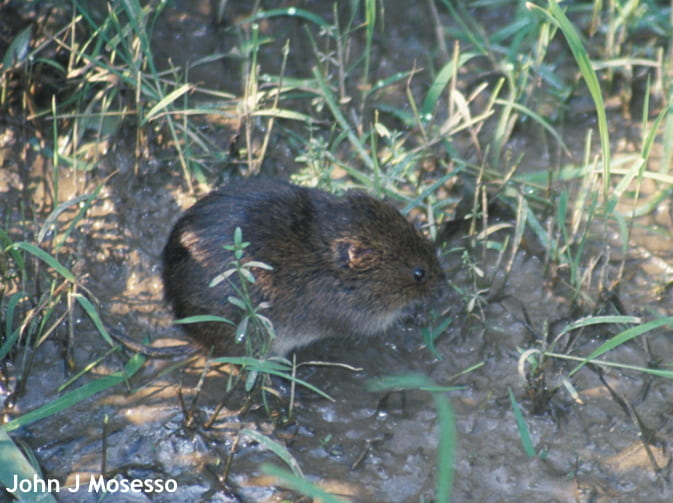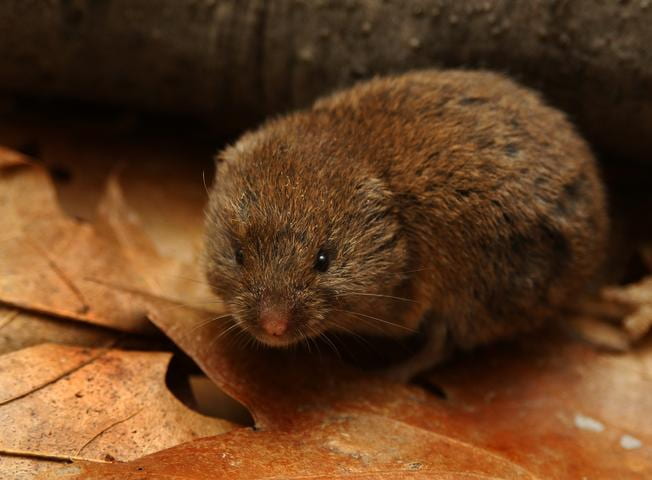Gordon Johnson, Extension Vegetable & Fruit Specialist; gcjohn@udel.edu
Voles may cause extensive damage to fruit trees and orchards as a result of girdling seedlings and trees and damaging roots. Damage occurs primarily during winter when other types of food are scarce. It is important to determine which species of vole occurs in your crop production sites. Vole species most commonly associated with depredation issues in the Mid-Atlantic region are the meadow vole (Microtus pennsylvanicus) and the woodland or pine vole (Microtus pinetorum). Meadow voles, also called meadow mice, are about 5½ to 7½ inches long, with fur that ranges from gray to yellow-brown with black-tipped hairs; they also display a bi-colored tail. Woodland voles are about 4-6 inches long.

Meadow Vole

Woodland Vole
The most common form of tree injury caused by meadow voles is trunk girdling at or near the ground surface. Since voles burrow in the snow, they may damage tree trunks as high as snow accumulates. Young trees are especially susceptible to attack. Occasionally, meadow voles will burrow in the soil and damage roots, resulting in weak, unhealthy trees.
Damage from woodland voles (pine voles) is harder to detect because it occurs underground as they consume small roots, girdle large roots, and eat bark from the base of trees. By the time orchardists note weak, unhealthy trees, the damage is already extensive.
Meadow voles spend much more time above ground than do woodland voles, but both species inflict serious damage. Meadow voles construct surface runways (approx. 1½ to 2 inches wide) under or within the accumulated organic matter and duff layer that exists in fields; these runs often terminate at a 1” diameter wide hole that drops into an underground burrow network. In contrast, pine voles remain underground. Both species are known for constructing burrows that follow trickle irrigation lines or areas where the soil has been loosened by mechanical planters.
Cultural practices and habitat modification measures are helpful in deterring vole populations. Voles avoid areas with few food resources and little protective cover. Control of ground vegetation with herbicides, mowers, or disking is effective, although voles will travel under snow cover in these areas. Herbicides are the preferred method to eliminate sod. Cultural practices that reduce the amount of organic litter around plants are essential. A final close mowing of the row middles, after harvest, should be utilized annually to further reduce habitat and cover for rodents and to enhance the effectiveness of natural predators (such as hawks and owls).
Exclusion methods are feasible only at small scales. Hardware cloth or woven wire fences (≤ ¼ inch) can be installed to a height of 1 ft above ground and buried to completely contain the rooting system of the plant. There are some newer products composed of sharp-edged rock or pumice granules that can be used to line the planting hole and will act much like a barrier against digging. This requires significant hand installation, so an analysis of cost-effectiveness is necessary before considering such methods.
Toxicants are used to control large vole populations and most are classified as Restricted Use Pesticides (RUP); these products can be applied only by a pesticide applicator who possesses both a general applicator certification and the advanced certification for vertebrate application (Category 7D). In most cases, voles must feed on treated baits multiple times to sustain a lethal dose. Therefore, bait stations must be stocked and maintained to ensure success. Zinc phosphide is a single-dose RUP available as a concentrate or in pelleted or grain bait applications. Because of its noticeable garlic odor and taste, voles eventually may shy away from or avoid bait stations stocked with ZP. Pre-baiting stations with untreated food for 2 to 3 days prior to applying the pesticide may increase success.
Anticoagulants may also be effective in controlling vole damage. However, anticoagulant baits are slow acting and may take up to 15 days to be successful. Furthermore, most anticoagulants require more than one feeding for maximum effectiveness.
To avoid danger to non-target species, the use of bait stations is recommended and may be required in some states. Hand placement of baits directly in enclosed runways and burrow openings within the tree drip line is essential for woodland vole control because of their subterranean behavior. To ensure the legality of a particular toxicant in your state, information can be obtained by calling your Pesticide Control Program. As with all use of toxicant products, follow the product’s labeling guidelines.
Information is from Orchard Wildlife – Integrated Management of Voles in Orchards from Penn State and the Mid-Atlantic Commercial Vegetable Production Recommendations.
